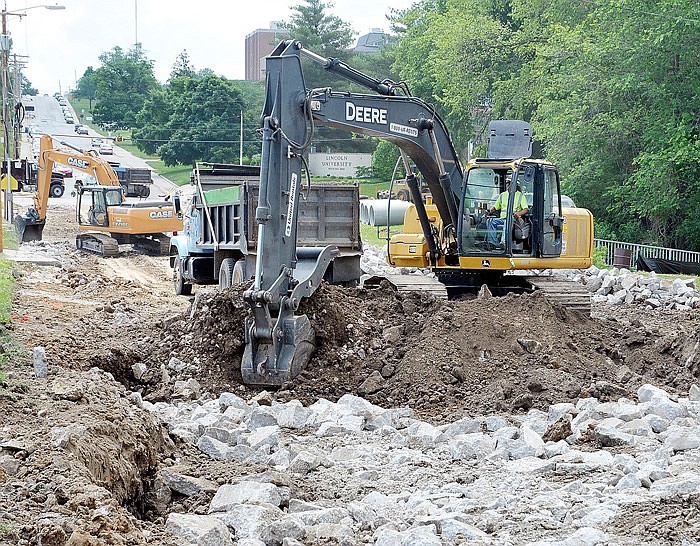Funding topics at Monday night's Jefferson City Council meeting ranged from street overlays, fire and police facilities, recreation development and digital development.
The council held a work session with the leaders of multiple city agencies to discuss projects that the next potential round of sales tax funds could be used for.
Every five years, the citizens of Jefferson City vote on whether to extend the sales tax or let it lapse. If approved, this cycle would be sales tax H.
The total estimated revenue per year would be $5.6 million for a total of $28 million.
The estimate for the current cycle was $5 million annually for a total of $25 million.
Representatives from public works, public safety, parks, IT and economic development spoke to council members about what work would take priority for each department.
Public Works
Nearly 60 percent of the projected revenue would be considered to go toward public works.
The proposed amount would be $16,520,000, which would be an increase of more than $1.7 million.
Director Matt Morasch said areas of work include overlay on streets that need repair work, stormwater systems, multiple grant matching projects and city-county cooperative projects.
The grant matching projects relate to transit, the airport, sidewalks and a local roadway study.
In terms of projects the city and Cole County could work together on, he discussed the High Street viaduct needing repairs for $5 million; the corridor from Stadium to Southwest as well as over toward Edgewood to address traffic and sidewalk issues for an estimated $3 million; and an economic development grant match of $3 million for additional projects that may come along.
City council members asked Morasch about previously discussed projects such as two-laning Monroe Street and a development on Mission Drive with the county.
He said those projects didn't come up as a priority at the moment, but he would be open to discussing them if the council felt it was important to do so.
Public Safety
The three main projects proposed under Public Safety include two facility updates and additional cameras for the police department.
Police Chief Roger Schroeder listed multiple projects, but said the two main ones and most costly ones would be renovating the police office and increasing cameras.
The request lists an additional floor, tile and door replacement, and office furniture for an estimated total of almost $8 million.
Schroeder also discussed a need for cameras within interview rooms, officer's cars and on officer's uniforms.
It is more efficient, he said, for those camera systems to be consolidated and he's received community input in support of body cameras.
The collection of these would cost an estimated $1.2 million over the course of the next five years.
Fire Chief Matthew Schofield discussed building a Fire Station No. 6 on Mission Drive.
He listed it for an estimated $3 million based on the previous budget for building Fire Station No. 2.
Schofield said if approved he would be asking for a similar building and layout to that one.
Parks and Recreation
Under the Parks and Recreation Department budget would be $2.8 million. The department operates slightly differently than the others since it is able to bring in its own revenue through a tax specified for parks and recreation.
Director Todd Spalding said the staff is still looking into the interest in an ice arena downtown near the Missouri State Penitentiary and trail connections to get more people connected to greenway systems.
He said those are the main priorities when looking at quality of life within the city and areas to generate revenue for multiple city departments.
Information Technology
The information technology department discussed $765,000 over the five years.
According to board documents, that funding would go toward computers/monitors, networking and GIS imagery equipment.
The new item on the request this year is a new door access system for the City Hall complex.
Margie Mueller, director of finance and information technology services, said the current system is reaching the end of its life. That would account for about $100,000.
Economic Development
Sonny Sanders, director of planning and protective services, recommended putting aside some of the funding for a demolition/acquisition program.
He said the city has 10 dangerous properties with 11 more in the process of being labeled as such. Collectively, those demolitions would cost an estimated $871,000, which is not in the current budget.
Sanders continued that the staff estimates five more buildings will be added to that list per year, but the current budget only allows for one demolition a year.
Going Forward
Additional discussion on the sales tax will be on the agenda for the March 1 meeting.
Council members Ron Fitzwater and Ken Hussey, wards 4 and 3 respectively, expressed wanting the additional time to consider all of the information presented and get more information on the topics.
Ward 4 councilman Carlos Graham said another measure projected to be on the March 1 agenda would be the consideration of a public safety tax.
Fitzwater and Graham also expressed concerns over discussing such important topics over a virtual platform.
"These are critical issues that impact our community for the next five or six years and trying to do it virtually, I just don't think we're doing our job as members of the council," Fitzwater said.
While he understands the current climate, Graham said, he agrees these care conversations the council should be having face-to-face.
Mayor Carrie Tergin pointed out that members of the public can be involved through joining the virtual call.
Tergin said based on the current COVID-19 numbers and the status of technology upgrades within the chamber halls, the council is on track to be back to meeting in
That may be a hybrid setting where members are in person, but visitors would still be virtual.
She said the topic would be discussed March 1.

